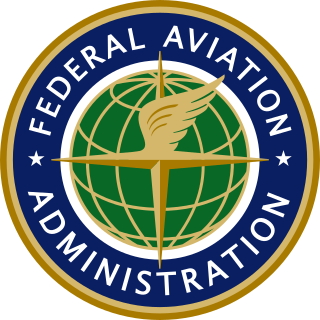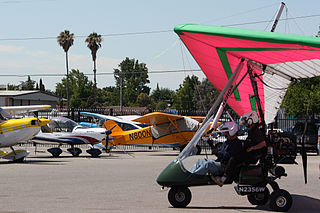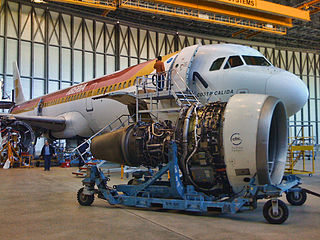Related Research Articles

The Federal Aviation Administration (FAA) is the largest transportation agency of the U.S. government and regulates all aspects of civil aviation in the country as well as over surrounding international waters. Its powers include air traffic control, certification of personnel and aircraft, setting standards for airports, and protection of U.S. assets during the launch or re-entry of commercial space vehicles. Powers over neighboring international waters were delegated to the FAA by authority of the International Civil Aviation Organization.
The Federal Aviation Regulations (FARs) are rules prescribed by the Federal Aviation Administration (FAA) governing all aviation activities in the United States. The FARs comprise Title 14 of the Code of Federal Regulations (CFR). A wide variety of activities are regulated, such as aircraft design and maintenance, typical airline flights, pilot training activities, hot-air ballooning, lighter-than-air aircraft, man-made structure heights, obstruction lighting and marking, model rocket launches, commercial space operations, model aircraft operations, Unmanned Aircraft Systems (UAS) and kite flying. The rules are designed to promote safe aviation, protecting pilots, flight attendants, passengers and the general public from unnecessary risk.

A type certificate signifies the airworthiness of a particular category of aircraft, according to its manufacturing design. Certification confirms that the aircraft of a new type intended for serial production is in compliance with applicable airworthiness requirements established by the national air law.

A light-sport aircraft (LSA), or light sport aircraft, is a fairly new category of small, lightweight aircraft that are simple to fly. LSAs tend to be heavier and more sophisticated than ultralight aircraft, but LSA restrictions on weight and performance separates the category from established GA aircraft. There is no standard worldwide description of an LSA.
The Canadian Aviation Regulations (CARs) are the rules that govern civil aviation in Canada.
An aircraft part is an article or component approved for installation on a type-certificated aircraft. Approval for these parts is derived from the jurisdictions of the countries that an aircraft is based. In the United States, the Federal Aviation Administration oversees the approval for these parts under Federal Aviation Regulation Part 21.
Parts Manufacturer Approval (PMA) is an approval granted by the United States Federal Aviation Administration (FAA) to a manufacturer of aircraft parts.
An Air Data Inertial Reference Unit (ADIRU) is a key component of the integrated Air Data Inertial Reference System (ADIRS), which supplies air data and inertial reference information to the pilots' electronic flight instrument system displays as well as other systems on the aircraft such as the engines, autopilot, aircraft flight control system and landing gear systems. An ADIRU acts as a single, fault tolerant source of navigational data for both pilots of an aircraft. It may be complemented by a secondary attitude air data reference unit (SAARU), as in the Boeing 777 design.
In aviation safety, master minimum equipment list, or MMEL, is a categorized list of on-board systems, instruments and equipment that may be inoperative for flight in a specified aircraft model. Procedures or conditions may be associated with items on the list. Any airworthiness-related equipment or system not on the list must be functional for flight.

In aviation, airworthiness is the measure of an aircraft's suitability for safe flight. Initial airworthiness is demonstrated by a certificate of airworthiness issued by the civil aviation authority in the state in which the aircraft is registered, and continuing airworthiness is achieved by performing the required maintenance actions.

Aircraft maintenance is the performance of tasks required to ensure the continuing airworthiness of an aircraft or aircraft part, including overhaul, inspection, replacement, defect rectification, and the embodiment of modifications, compliance with airworthiness directives and repair.

China Airlines Flight 120 was a regularly scheduled flight from Taiwan Taoyuan International Airport in Taoyuan County, Taiwan to Naha Airport in Okinawa, Japan. On August 20, 2007, the Boeing 737-800 aircraft operating the flight caught fire and exploded after landing and taxiing to the gate area at Naha Airport. Four people—three from the aircraft and one ground crew—sustained injuries in the accident. The fire had been caused by a loose bolt puncturing a fuel tank.

In aviation, V-speeds are standard terms used to define airspeeds important or useful to the operation of all aircraft. These speeds are derived from data obtained by aircraft designers and manufacturers during flight testing for aircraft type-certification. Using them is considered a best practice to maximize aviation safety, aircraft performance, or both.

Automatic Dependent Surveillance–Broadcast (ADS-B) is an aviation surveillance technology and form of Electronic Conspicuity in which an aircraft determines its position via satellite navigation or other sensors and periodically broadcasts its position and other related data, enabling it to be tracked. The information can be received by air traffic control ground-based or satellite-based receivers as a replacement for secondary surveillance radar (SSR). Unlike SSR ADS-B does not require an interrogation signal from the ground or other aircraft to activate its transmissions. ADS-B can also receive point-to-point by other nearby equipped "ADS-B In" equipped aircraft to provide traffic situational awareness and support self-separation. ADS-B is "automatic" in that it requires no pilot or external input to trigger its transmissions. It is "dependent" in that it depends on data from the aircraft's navigation system to provide the transmitted data.

The Directorate General of Civil Aviation (DGCA) is a statutory body of the Government of India to regulate civil aviation in India. It became a statutory body under the Aircraft (Amendment) Act, 2020. The DGCA investigates aviation accidents and incidents, maintains all regulations related to aviation and is responsible for issuance of licenses pertaining to aviation like PPL's, SPL's and CPL's in India. It is headquartered along Sri Aurobindo Marg, opposite Safdarjung Airport, in New Delhi. The Government of India is planning to replace the organisation with a Civil Aviation Authority (CAA), modelled on the lines of the American Federal Aviation Administration (FAA).
An emergency Airworthiness Directive (EAD) is an airworthiness directive issued when an unsafe condition exists that requires immediate action by an aircraft owner or operator. An EAD is published by a responsible authority such as the FOCA, EASA or FAA related to airworthiness and maintenance of aircraft and aircraft parts. It contains measures which must be accomplished and the related periods to preserve their airworthiness. Technical information is addressed to operators and maintenance organisations of affected aircraft only. EADs become effective upon receipt of notification.
Advisory circular (AC) refers to a type of publication offered by the Federal Aviation Administration (FAA) to provide guidance for compliance with airworthiness regulations, pilot certification, operational standards, training standards, and any other rules within the 14 CFR Aeronautics and Space Title. They define acceptable means, but not the only means, of accomplishing or showing compliance with airworthiness regulations. Generally informative in nature, Advisory Circulars are neither binding nor regulatory; yet some have the effect of de facto standards or regulations.

Regulation of unmanned aerial vehicles (UAVs) involves setting safety requirements, outlining regulations for the safe flying of drones, and enforcing action against errant users.

The Boeing 737 MAX passenger airliner was grounded worldwide between March 2019 and December 2020 – longer in many jurisdictions – after 346 people died in two similar crashes: Lion Air Flight 610 on October 29, 2018 and Ethiopian Airlines Flight 302 on March 10, 2019. The U.S. Federal Aviation Administration (FAA) resisted grounding the aircraft until March 13, 2019, when it received evidence of accident similarities. By then, 51 other regulators had already grounded the plane, and by March 18, 2019, all 387 of the aircraft in service were grounded.

FAA Order 8110.37 , Designated Engineering Representative (DER) Handbook, is a handbook of procedures, technical guidelines, limitations of authority, tools, and resources for Designated Engineering Representatives (DERs), who are appointees of the Federal Aviation Administration. Both DERs and the FAA offices managing them have individual and mutual roles and responsibilities in the certifications of safety of aircraft and aviation systems. This handbook provides a better understanding of these roles. Although intended for the roles of DERs, this order may be useful to ODA engineering Unit Members, who are effectively DERs managed by aviation manufacturers rather than by the FAA.
References
- 1 2 3 Transport Canada (October 2008). "Aeronautical Information Manual, LRA – 2.0 Aircraft Airworthiness, Airworthiness Directives". Archived from the original on 17 April 2011. Retrieved 3 November 2008.
- 1 2 Transport Canada (January 2008). "Canadian Aviation Regulation 605.84 Aircraft Maintenance – General". Archived from the original on 7 December 2008. Retrieved 3 November 2008.
- 1 2 3 4 Transport Canada (January 2008). "Canadian Aviation Regulation Standard 593.02 Airwothiness Directives". Archived from the original on 18 May 2013. Retrieved 3 November 2008.
- ↑ Pilot's Handbook of Aeronautical Knowledge . US Department of Transportations, Federal Aviation Administration. 2016. pp. 9–12.
- 1 2 Federal Aviation Administration (October 2009). "Types of Airworthiness Directives". Archived from the original on 16 October 2009. Retrieved 4 October 2009.